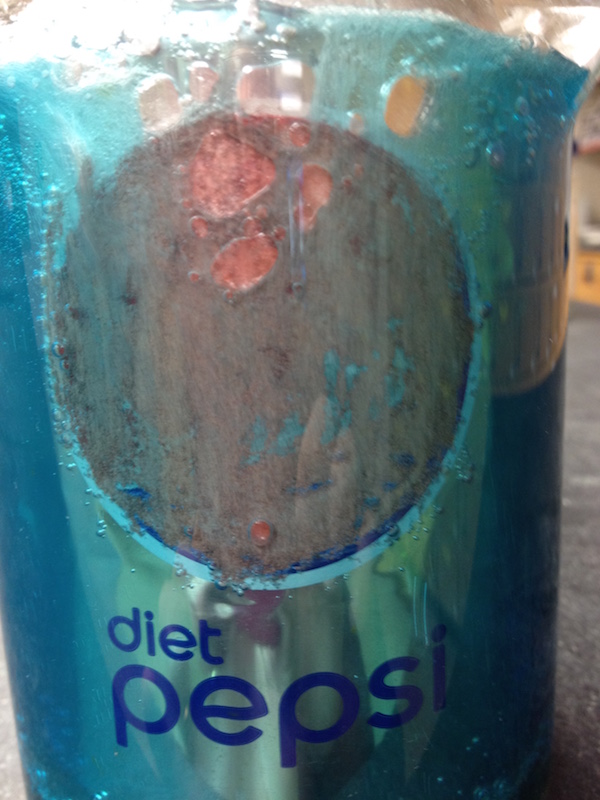
January 2017:
Have you ever seen a can crushed? How about one that has been ripped apart? Crushing an aluminum can may not take that much strength but ripping one apart would be very difficult to do. That is unless you’ve had a little chemical help.
Materials:
- Copper Sulfate (can be found as root killers at many stores) or copper(II) chloride
- Salt (not necessary if you have copper(II) chloride)
- Aluminum can
- Glass or plastic container that will hold the soda-pop can
Sandpaper
Please note: All chemicals and experiments involve an element of risk, and no experiments should be performed without proper adult supervision.
Using the sandpaper, remove two squares of paint about the size of the UPC symbol (I have used a Dremel tool to remove the paint much more quickly) – see picture A. Do this on opposite sides of the can. The paint protects the aluminum underneath it so that the aluminum does not easily react with other things. The bottom of the can does not have paint and will be eaten away by the copper solution so you may want to put some plastic wrap around the bottom secured with a rubber band. Fill the can with water and place it inside the glass or plastic container. Pour some copper sulfate into the glass or plastic container on the outside of the pop can – see picture B. Normally this reaction happens much faster if you use copper chloride but if that is not readily available you can simply add some salt to the copper sulfate. In a short period of time you will begin to see the blue translucent solution turn murky and some brownish red solid begin to appear. You will also see some gas evolved. After about 30 minutes you can remove the can from the container and you will notice a thin film holding the water inside the can – see picture C. Be careful with how you handle the can because the plastic liner is easily broken.
| Picture A | Picture B | Picture C |
 |
 |
 |
What’s happening?
It turns out that aluminum is really quite reactive and so to protect the can from other things we put paint on the outside of the can and a plastic liner to protect the inside of the can. It is believed that the chloride from the salt is necessary to start etching away at the oxide pits on the surface of the metal. Once the pure aluminum is exposed, the copper ions will oxidize the aluminum metal to colorless aluminum ions while the blue copper ions get reduced to brownish red copper metal. The aluminum ions are washed away into the solution leaving nothing behind but the plastic liner.
To set up the can to be able to rip it in half, this can be done in two ways. You can score the can on the outside so that you take away the paint. However, this will deface the can on the outside and you will notice that something is amiss with the can. On the other hand you can score the can on the inside so that you remove a thin line of the plastic liner on the inside of the can and when the aluminum is eaten away by the copper ions, it will leave only the paint holding the two halves of the can together.
Waste:
If there is any blue remaining in the solution, add some aluminum foil until the blue disappears. The metal can and the solid copper can be thrown into the trash can. The colorless solution can go down the drain with lots of water.
To see how you can set up a can to rip it apart, see the following video.
https://www.youtube.com/watch?v=BK0x5v0Kb7A
References:
This experiment is referred to in the October 1993 ChemShorts article of the Bulletin
http://chicagoacs.net/archive/ChmShort/CS93.html#10.93
To view all past “ChemShorts for Kids”, go to: http://chicagoacs.org/articles.php?article_category=1
Paul Brandt
